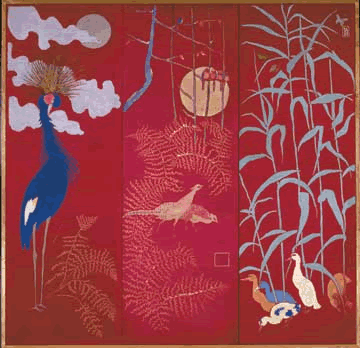


Pierre Bonnard. Ducks, Heron, and Pheasants, 1889. Distemper on red-dyed cotton fabric. Tom James Co./Oxxford Clothes (cat. no. 1)
This is one of two folding screens that Pierre Bonnard made for his sister, Andrée, shortly before her marriage to composer Claude Terrasse. Both the format and the subject demonstrate Bonnard's enthusiasm for Japanese art, which caused him to be dubbed the "very Japanese Nabi." In this screen, Bonnard created a poetic nocturne in which a full moon illuminates singing birds, fluttering butterflies, ducks, and a pair of pheasants. The large blue heron on the left, a Japanese symbol of long life, may also be related to a fable by the 17th-century writer Jean de La Fontaine. The red color of the screen’s cotton fabric, which may have either been inspired by Chinese lacquerware or perhaps by Paul Gauguin’s painting The Vision after the Sermon, provides a striking background for the bold, flat plant and animal forms.
Last updated: February 2001. Best viewed with Netscape Navigator 4.2 or higher. Many elements of this site require Quicktime 4.1.2 or later. © 2001.The Art Institute of Chicago. 111 South Michigan Avenue, Chicago, Illinois, 60603-6110. Reproduction Permission. All rights reserved. Unauthorized use is prohibited.
technical support: webmaster@artic.edu